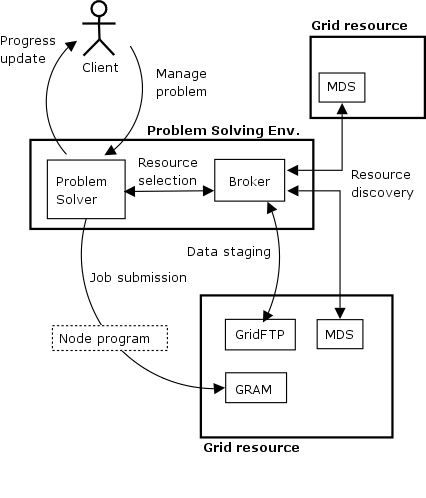|
||
Assignment 2 - A fault tolerant high-throughput PSE
IntroductionThe purpose of this assignment is to give practical experience of Globus programming. The assignment covers a broad range of GT4 services and protocols, including information services, job submission, data transfer, and security. An additional purpose of the assignment is for you to gain deeper understanding of resource discovery, scheduling, and secure communication. The assignment will also highlight the benefits and drawbacks of programming for the Grid. The assignment shall be solved in groups of two students.SpecificationYour task is to implement a system for solving embarrassingly parallel problems on the Grid using a master-worker approach. The overall goal of the system is to solve the problem as quickly as possible. The problem can be selected freely, as long as it fulfills the following requirements:
You are of course allowed (and even encouraged) to solve a problem of your own choice. Notify your choice of problem to the assistants. Architectural overviewThe system consists of a client and a problem solving environment. Conceptually, the problem solving environment can be decomposed into three modules, a problem solver, a node program and a resource broker.The problem solver partitions the problem into subproblems, requests appropriate Grid resources from the resource broker, and submits jobs solving the subproblems to the selected Grid resources. When working on a problem, the problem solver updates the client of the progress using notifications. Once all subproblems are solved, the problem solver generates the solution to the overall problem from the solutions of the subproblems. The node program solves one subproblem on a Grid resource selected by the broker, i.e., the node program will be submitted in a job to the Grid resource. Note that the focus of this assignment should be on the resource broker and the problem solver, do not spend much time implementing a node program. The resource broker finds available Grid resources, classifies which of those are appropriate for running the node program and selects a resource for the subproblem. When selecting resources, the broker must consider both the current load of the resource and the performance of jobs previously executed on that resource. The latter includes both the execution times of the jobs and the ratio of the jobs that have failed. Carefully describe and motivate your resource selection algorithm in the report. One must also consider how often the resource broker should retrieve new MDS information. Too frequent updates result in large overhead, while too infrequent updates may result in poor resource selection. The broker should furthermore be able to stage files to and from the Grid resources. The below picture shows one possible decomposition of the system into modules. Other decompositions are possible. 
RequirementsThe implemented system must meet the following requirements.
The system must gather the following data during its execution.
In addition to the basic functionality, your system must support the following.
Non-mandatory extensionsThe following extensions are not mandatory, but improves the system. The only reward for implementing these items is deeper knowledge of Grid programming, and possibly, some street-cred from the other students.
Hints and adviseThis assignment can be confronted in many different ways. The following list suggests one approach:
It is generally beneficial to build modular systems. Initially, try each component out, add more functionality and a general interface as your gain more experience of the component. Try to make it as easy as possible to plug the new component into the system. The coupling between the problem (the node program) and the problem solver should be as loose as possible. Ideally, one should be able to use another node program without modifying the problem solver. Libraries for the complete Globus toolkit (including GRAM, MDS etc), can be found in /pkg/gt4/4.0.1 on all machines in MA416 and MA426. ExaminationThe examination of this assignment consists of four parts, namely:
The second part is the progress discussion, where you discuss your progress so far with the teaching assistants. This discussion should also cover how you will tackle the remaining work, and ventilate any concerns and problems. You may choose the date for your progress discussion freely, but this date must be set when you hand in your design. The report shall thoroughly document the structure of your solution and motivate your design. Do however not include any test runs as the correctness of your system (or lack thereof) will be shown during the demonstration. Furthermore, the report shall contain an analysis of a larger test run. This analysis should determine the speedup of your system (compare with solving the problem using only one machine in MA446). The report should also discuss the strengths and weaknesses of the brokering algorithm. Finally, each group of students will hold a 20 minute demonstration of their system for the teaching assistants. This demonstration is an opportunity to show the finer details of your implementation. You should also be prepared to answer questions regarding your design and brokering algorithm as well as discuss the benefits and drawbacks of your system.
The executable program must run on the department of computing science's Linux system. All code must be placed in the directory ~/edu/grid/lab2. Due dates2007-02-08: DesignYour choice: Progress discussion 2007-03-07: Demonstration 2007-03-09: Report Useful links:The Globus Toolkit 4 Programmer's tutorialJava CoG 1.2 API (GridFTP etc.) Globus Toolkit Java WS Core API (includes notifications) Axis API RSL Schema Submitting a GRAM job in Java Gram Service API Gram Client API Gram Util API MDS Public Interface Guide Can't find it? Try the complete Globus documentation FAQ - will be updated with answers to your questions. |
||
|
http://www.cs.umu.se/kurser/TDBD20/VT07/lab/lab2.html Ansvarig för sidan: Erik Elmroth, P-O Östberg, Johan Tordsson Senast ändrad 2007-01-29 |

